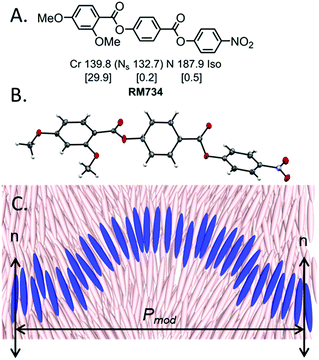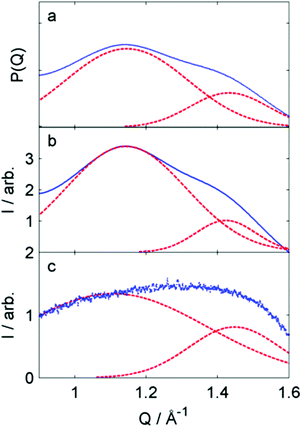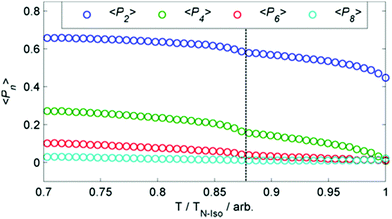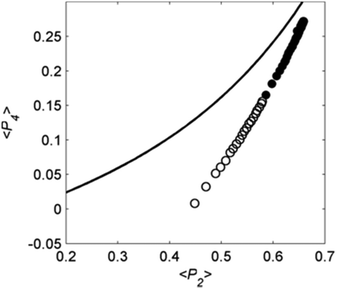 Open Access Article
Open Access ArticleCreative Commons Attribution 3.0 Unported Licence
Orientational order in the splay nematic ground state†
Richard J.
Mandle
 *a and
Alenka
Mertelj
*a and
Alenka
Mertelj
 b
b
aDepartment of Chemistry, University of York, York, YO10 5DD, UK. E-mail: richard.mandle@york.ac.uk
bJ. Stefan Institute, SI-1000 Ljubljana, Slovenia
First published on 20th August 2019
Abstract
Modulated nematic liquid crystal phases, which lack positional order but have some periodic variation in the direction of average orientation present in a classical nematic, have attracted significant interest. In the recently discovered splay nematic (NS) phase the average orientational order is augmented with a periodic splay deformation of orientation perpendicular to the director. We use X-ray scattering experiments to measure the orientational order parameters in the nematic (N) and splay nematic (NS) phases of the liquid crystalline material RM734. The degree of orientational order is somewhat larger in the NS phase than in the preceding nematic and temperature dependent. We reconstruct the orientational distribution function and find it to be nematic-like in the NS phase, indicating the change in orientation between neighbouring molecules due to the splay modulation is very small. A small splay angle implies that the splay modulation period is larger than the few tens of nanometers originally envisaged. The method described herein can be used to assist in unambiguous identification of the splay-nematic phase.
Introduction
Nematic liquid crystal phases, in which there is an average orientational order of the molecules but a lack of positional order, are the cornerstone of the display industry. New nematic ground states are rare, and in the 21st century the prediction and subsequent discovery of nematic phases with periodic modulation of their orientation has generated significant interest.1–5 The most widely studied of these recently observed nematic variants is the twist-bend nematic (NTB), in which the average orientational direction precesses about a cone along the optic axis giving rise to a helical structure with a periodicity of a few molecular lengths.6–8Some years ago we reported rod-shaped materials which exhibit two nematic phases separated by a weak first order phase transition.9 One of these materials (RM734, Fig. 1A)10 was studied in detail by Mertelj et al., who found the higher temperature phase to be a classical nematic phase, and the lower temperature nematic to be a nematic phase with a periodically splayed local director – a splay nematic phase (NS, Fig. 1C).11 The experimental observation of the splay nematic ground state satisfied an earlier prediction of such a phase.12 Chaturvedi and Kamien recently discussed how the NS is related to the splay-bend nematic phase (NSB) described by Dozov through exchange of the splay and bend elastic constants;1,13 the modulation vector is perpendicular to the director in the NS phase and parallel in the NSB. It is possible that the ‘MP’ phase reported by Kikuchi et al. is another example of the splay nematic phase.14 Barbero and Lelidis recently discussed the possibility of periodic modulated splay-nematic phases that results from a negative value of K11.15 The proposed structure of the NS phase is polar, biaxial and antiferroelectric and therefore of significant interest for electrooptic devices. However, there is a need to better characterise the structure of this phase, and to devise methods for unambiguous identification.
 | ||
| Fig. 1 (A) Molecular structure, transition temperatures (°C) and associated enthalpies [kJ mol−1] of RM734;10 (B) ORTEP model of RM734 obtained by XRD as described in ref. 11 with thermal ellipsoids at 50% probability; (C) cartoon depiction of a single period (Pmod) of the periodic splay deformation of the director (n) in the NS phase. | ||
For the twist-bend modulated nematic phase, X-ray scattering experiments can be used to measure the order parameters which can then be used to calculate the heliconical tilt angle.7,8 From the proposed model of the NS phase11 one can imagine that the periodicity of the splay-nematic phase is inversely related to the splay-angle between neighbouring molecules, i.e. a large periodic length scale leads to a small angle and vice versa. In the case of a small periodic length scale, this angle may be measurable by X-ray scattering experiments. However, its absence would support the idea that the periodic length scale of the NS phase is large, rather than being on the order of a few nanometers.
Experimental
Materials used in this study were prepared as described previously.10 The first five even orientational order parameters (〈Pn〉) of RM734 were determined by wide angle X-ray scattering (WAXS) using the method described in ref. 16 and 17 Samples were filled into 0.9 mm I.D. borosilicate glass capillary tubes purchased from Capillary Tube Supplies UK Ltd. Briefly, 2D WAXS patterns were recorded as a function of temperature in 3 °C intervals over a temperature range of 195 °C to 48 °C (T/TN-Iso range of 1.01 to 0.69) with an exposure time of 300 seconds and a sample to detector distance of 121 mm, allowing simultaneous recording of small and wide angle data. The 2D WAXS pattern obtained from an empty glass capillary was used as a background. Following background subtraction we performed azimuthal integration (1° step size). Fitting according to eqn (1) allows the orientational order parameters to be determined; eqn (2) and (3) show this for 〈P2〉 while details for higher order parameters are given in the ESI.† | (1) |
 | (2) |
 | (3) |
Form factors and scattering intensities were calculated from atomic coordinates using the ATSAS 2.8 software package.18–20
Results and discussion
As discussed in an earlier paper, when studied by X-ray scattering experiments the wide-angle peak RM734 (and related materials) is found over a particularly large angular range and can be deconvoluted into two overlapping peaks (Fig. 2c) at 1.14 Å−1 and 1.49 Å−1. This is behaviour is observed not only in the NS phase, but also in the nematic and isotropic liquid. If both wide-angle peaks originate from a single molecule then the analysis presented in eqn (1)–(3) can still be used, whereas if one of the peaks originates from local phase biaxiality in the NS phase then this approach may no longer be valid. That the two wide angle peaks are observed in the isotropic liquid and both nematic phases are strong indicators that they do not originate from biaxial local order, however we sought further demonstration that these originate from the molecular shape of RM734 by calculating the molecular form factor (Fig. 2a) and scattered intensity profile (Fig. 2b). The molecular form factor of RM734 shows two diffuse features whose scattering vectors (1.15 Å−1 and 1.44 Å−1) match both calculated isotropic wide-angle scattering data (Fig. 2b) and experimental scattering data in the isotropic liquid (Fig. 2c). Plots of intensity versus Q for the nematic and NS phases are given in the ESI,† (Fig. SI2); these show that the position of the deconvoluted peaks does not vary in the different phases (Iso, N, NS), which is to be expected given their origin in molecular shape.Having established the origin of the two wide angle peaks, we next measured the orientational order parameters of RM734 as a function of temperature across the nematic and NS phases. As shown in Fig. 3, both 〈P2〉 and 〈P4〉 increase across the nematic phase, reaching maximum values of ∼0.55 and ∼0.15, respectively. At the NS–N transition there is a jump in both 〈P2〉 and 〈P4〉; in the splay nematic phase we find values in the range ∼0.60–0.66 and ∼0.20–0.27 for 〈P2〉 and 〈P4〉, respectively. Values of 〈P6〉 follow the same trend as 〈P2〉 and 〈P4〉, being in the range 0.00–0.04 in the nematic phase, and 0.05–0.10 in the NS phase. We also determined the higher order parameters 〈P8〉 and 〈P10〉; the former is zero in the nematic phase and increases slightly to take a maximum value of ∼0.03 in the NS phase, whereas the latter is effectively zero at all temperatures studied. We note that at the NS–N phase transition there is a clear discontinuity in the first three order parameters, which is to be expected due to the first order nature of this phase transition.
Plotting 〈P2〉 versus 〈P2〉 allows us to remove the explicit temperature dependence of the two principal order parameters, as shown in Fig. 4. Empty data points correspond to RM734 in the nematic phase; filled data points correspond to the splay-nematic phase of the same material. This shows that the relationship between 〈P2〉 and 〈P4〉 is the same in the nematic and NS phases of RM734, with values simply being larger in the lower temperature nematic phase. Experimental orientational order parameters were compared with Maier–Saupe (MS) theory, presented as a solid black line. It is immediately apparent that, at a given value of 〈P2〉 the corresponding value of 〈P4〉 is smaller than is predicted by either MS theory. It should be noted that MS theory is concerned with predicting the orientational properties of uniaxial nematic liquid crystals and so it is therefore not surprising that it fails to describe the orientational properties of the splay modulated nematic phase, however, this does highlight the need for an analytic theory of this phase of matter to be developed.
From the first five even orientational order parameters we reconstruct the orientational distribution function (ODF) across the temperature range studied (Fig. 5a). Truncating the reconstruction of the ODF at the 5th 〈P2n〉 term (ESI,† eqn (S12)) or the sixth f2n term (ESI,† eqn (S13)) gave essentially identical results. The use of higher order parameters (i.e. 〈P8〉, 〈P10〉) allows finer detail to be resolved in the ODF which may otherwise be lost through truncation effects. In both the nematic and splay nematic phases the ODF is (to a first approximation) Gaussian with its maxima at β = 0°, indicating that in terms of orientational order the NS phase is locally similar to the preceding nematic (Fig. 5b). As would be expected, we find the FWHM of the ODF decreases as a function of temperature, with a small discontinuity at the NS–N transition (Fig. 5c). The change in orientation from one molecule to its nearest neighbours that results from the splay modulation is therefore small enough that it is not observable by WAXS. The implication is that the periodicity of the NS phase is large rather than being of the order of a few nanometers as is the case with the NTB phase.
We also studied the orientational order of an analogue of RM734 used in this work in which the nitro group is replaced with a nitrile, in this manuscript we refer to this material as ‘RM734-CN’ and it has the phase sequence Cr 173.2 N 200.4 Iso. RM734-CN does not exhibit the splay-nematic phase, the temperature dependence of the first four even 〈Pn〉 order parameters is typical of that of a nematic phase, and the discontinuity observed at the NS–N transition for RM734 is absent. Further discussion and data are given in the ESI.† The behaviour of the orientational order parameters at the NS–N transition appears to be unique, and is distinct from other presently known modulated nematic phases.7,8 Measurement of the orientational order parameters by WAXS – coupled with the absence of Bragg scattering in small-angle X-ray scattering (SAXS) to confirm a positionally disordered phase – could be considered diagnostic of the splay nematic phase, and therefore provides a means to identify of this phase of matter.
Conclusions
Wide-angle X-ray scattering experiments have been used to probe the orientational order in the nematic (N) and splay nematic (NS) phases of the liquid crystalline material RM734. The NS phase displays a slightly greater degree of orientational order than the classical nematic phase, with a discontinuous increase in the first four even 〈Pn〉 order parameters at the NS–N phase transition, whereas 〈P10〉 was found to be effectively zero at all temperatures. Reconstruction of the orientational distribution function (ODF), and the lack of off axis correlation peaks indicates that the change in orientation between two neighbouring molecules that results from the splay modulation of the NS phase is small, too small to be measured by WAXS. This suggests that the periodicity of the splay-nematic phase, at least in RM734, is larger than the few tens of nanometers envisioned originally.11Conflicts of interest
There are no conflicts to declare.Acknowledgements
The EPSRC is thanked for funding the Bruker D8 SAXS/WAXS equipment used in this work via grant EP/K039660/1. AM acknowledges the financial support from the Slovenian Research Agency (research core funding No. P1-0192).Notes and references
- I. Dozov, Europhys. Lett., 2001, 56, 247–253 CrossRef CAS.
- M. Cestari, S. Diez-Berart, D. A. Dunmur, A. Ferrarini, M. R. de la Fuente, D. J. Jackson, D. O. Lopez, G. R. Luckhurst, M. A. Perez-Jubindo, R. M. Richardson, J. Salud, B. A. Timimi and H. Zimmermann, Phys. Rev. E: Stat., Nonlinear, Soft Matter Phys., 2011, 84, 031704 CrossRef CAS PubMed.
- D. Chen, M. Nakata, R. Shao, M. R. Tuchband, M. Shuai, U. Baumeister, W. Weissflog, D. M. Walba, M. A. Glaser, J. E. Maclennan and N. A. Clark, Phys. Rev. E: Stat., Nonlinear, Soft Matter Phys., 2014, 89, 022506 CrossRef PubMed.
- R. J. Mandle, Soft Matter, 2016, 12, 7883–7901 RSC.
- A. Jakli, O. D. Lavrentovich and J. V. Selinger, Rev. Mod. Phys., 2018, 90, 045004 CrossRef CAS.
- C. Zhu, M. R. Tuchband, A. Young, M. Shuai, A. Scarbrough, D. M. Walba, J. E. Maclennan, C. Wang, A. Hexemer and N. A. Clark, Phys. Rev. Lett., 2016, 116, 147803 CrossRef PubMed.
- G. Singh, J. X. Fu, D. M. Agra-Kooijman, J. K. Song, M. R. Vengatesan, M. Srinivasarao, M. R. Fisch and S. Kumar, Phys. Rev. E, 2016, 92, 060701 CrossRef PubMed.
- R. J. Mandle and J. W. Goodby, Phys. Chem. Chem. Phys., 2019, 21, 6839–6843 RSC.
- R. J. Mandle, S. J. Cowling and J. W. Goodby, Phys. Chem. Chem. Phys., 2017, 19, 11429–11435 RSC.
- R. J. Mandle, S. J. Cowling and J. W. Goodby, Chemistry, 2017, 23, 14554–14562 CrossRef CAS PubMed.
- A. Mertelj, L. Cmok, N. Sebastian, R. J. Mandle, R. R. Parker, A. C. Whitwood, J. W. Goodby and M. Copic, Phys. Rev. X, 2018, 8, 041025 CAS.
- H. Pleiner and H. R. Brand, Europhys. Lett., 1989, 9, 243–249 CrossRef CAS.
- N. Chaturvedi and R. D. Kamien, eprint arXiv:1904.09210, 2019, arXiv:1904.09210.
- H. Nishikawa, K. Shiroshita, H. Higuchi, Y. Okumura, Y. Haseba, S. I. Yamamoto, K. Sago and H. Kikuchi, Adv. Mater., 2017, 29, 1702354 CrossRef PubMed.
- G. Barbero and I. Lelidis, Liq. Cryst., 2019, 46, 535–542 CrossRef CAS.
- M. T. Sims, L. C. Abbott, R. M. Richardson, J. W. Goodby and J. N. Moore, Liq. Cryst., 2018, 46, 11–24 CrossRef.
- D. M. Agra-Kooijman, M. R. Fisch and S. Kumar, Liq. Cryst., 2018, 45, 680–686 CrossRef CAS.
- P. V. Konarev, V. V. Volkov, A. V. Sokolova, M. H. J. Koch and D. I. Svergun, J. Appl. Crystallogr., 2003, 36, 1277–1282 CrossRef CAS.
- D. Franke, M. V. Petoukhov, P. V. Konarev, A. Panjkovich, A. Tuukkanen, H. D. T. Mertens, A. G. Kikhney, N. R. Hajizadeh, J. M. Franklin, C. M. Jeffries and D. I. Svergun, J. Appl. Crystallogr., 2017, 50, 1212–1225 CrossRef CAS PubMed.
- D. Svergun, C. Barberato and M. H. J. Koch, J. Appl. Crystallogr., 1995, 28, 768–773 CrossRef CAS.
Footnote |
| † Electronic supplementary information (ESI) available. See DOI: 10.1039/c9cp03581h |
| This journal is © the Owner Societies 2019 |




